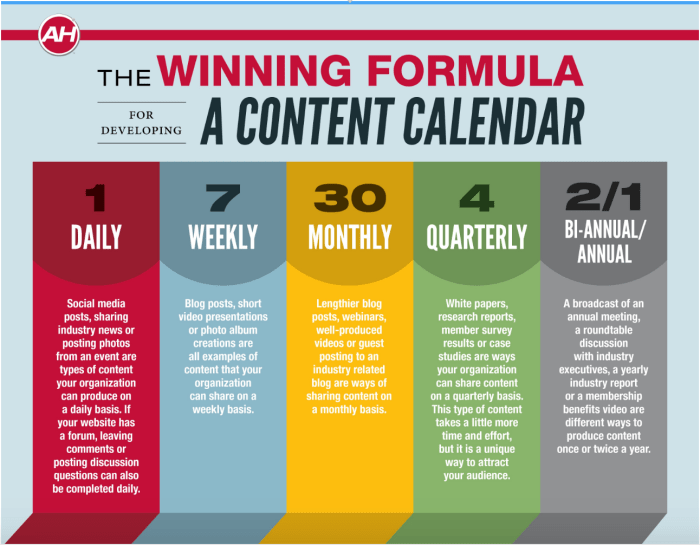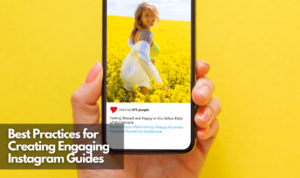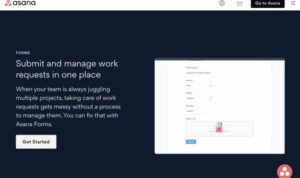Building Social Media Content Calendars is the key to unlocking your business potential in the digital world. From planning to execution, these calendars play a crucial role in keeping your social media game strong.
Get ready to dive into the world of social media content planning and take your online presence to the next level.
Importance of Social Media Content Calendars
In today’s digital age, having a strategic social media presence is essential for businesses looking to reach their target audience and drive engagement. One key tool that helps in achieving this is a social media content calendar.
Effective Planning and Organization
Social media content calendars provide businesses with a structured way to plan and organize their posts. By mapping out the content in advance, businesses can ensure a consistent flow of posts that align with their overall marketing strategy. This helps in avoiding last-minute scrambling for content ideas and ensures that posts are well-thought-out and impactful.
Consistency and Engagement
Consistency is key when it comes to social media marketing. Content calendars assist businesses in maintaining a regular posting schedule, which helps in building brand awareness and keeping the audience engaged. By having a clear plan of what to post and when, businesses can create a cohesive brand image and establish themselves as reliable sources of information in their industry.
Efficiency and Time Management
Moreover, content calendars also aid in efficient time management. By scheduling posts in advance, businesses can save time and focus on other important aspects of their marketing strategy. This allows for better utilization of resources and ensures that social media efforts are well-coordinated and effective.
Creating a Social Media Content Calendar

Creating a social media content calendar is crucial for maintaining a consistent online presence and engaging with your audience effectively. Here are the steps involved in creating a social media content calendar:
Step 1: Set Your Goals
Before you start planning your content calendar, identify your social media goals. Whether it’s increasing brand awareness, driving website traffic, or boosting engagement, your goals will shape your content strategy.
Step 2: Know Your Audience
Understanding your target audience is key to creating content that resonates with them. Research their preferences, interests, and behaviors to tailor your content calendar accordingly.
Step 3: Choose Your Platforms
Decide which social media platforms are most relevant to your business and where your audience is most active. Focus your efforts on these platforms to maximize your reach and engagement.
Step 4: Plan Your Content
Brainstorm ideas for content that align with your goals and resonate with your audience. Create a mix of promotional, educational, entertaining, and engaging posts to keep your followers interested.
Step 5: Schedule Your Posts
Use a social media management tool like Hootsuite, Buffer, or CoSchedule to schedule your posts in advance. This will help you stay organized and maintain a consistent posting schedule.
Choosing the Right Tools
When selecting tools for creating and managing content calendars, consider factors like ease of use, collaboration features, analytics capabilities, and integration with social media platforms. Some popular tools include Trello, Asana, and Google Calendar.
Content Calendar Templates, Building Social Media Content Calendars
There are many content calendar templates available online that businesses can use to plan their social media content. These templates typically include sections for content ideas, publication dates, platforms, and post types. Customize a template to fit your specific needs and preferences.
Content Planning and Scheduling: Building Social Media Content Calendars
When it comes to creating killer social media content, planning and scheduling are key components to success. By brainstorming ideas, scheduling posts effectively, and balancing promotional and engaging content, you can keep your audience engaged and grow your following.
Brainstorming and Generating Ideas
Coming up with fresh and exciting content ideas can be a challenge, but it’s essential for keeping your social media channels lively. To brainstorm effectively, consider your target audience, trending topics, industry news, and upcoming events. Get creative and think outside the box to stand out from the crowd.
Scheduling Posts Effectively
Using a content calendar is a game-changer when it comes to scheduling posts effectively. By planning out your content in advance, you can ensure a consistent posting schedule and avoid last-minute scrambling. Consider using social media management tools to schedule posts across multiple platforms and track engagement metrics.
Balancing Promotional and Engaging Content
Finding the right balance between promotional and engaging content is crucial for maintaining a healthy social media presence. While it’s important to promote your products or services, it’s equally important to share valuable and entertaining content that resonates with your audience. Mix in behind-the-scenes looks, user-generated content, polls, contests, and interactive posts to keep your followers coming back for more.
Content Types and Themes
In the world of social media, it’s crucial to have a good mix of content types and themes to keep your audience engaged and interested. By incorporating a variety of content, you can appeal to different preferences and ensure that your social media channels remain fresh and exciting.
Different Types of Content
- Visual Content: Eye-catching images, videos, and infographics that grab attention.
- Text-based Content: Engaging posts, articles, and captions that tell a story or convey information.
- User-Generated Content: Content created by your audience, such as testimonials, reviews, or photos.
- Promotional Content: Posts that highlight products, services, or special offers.
- Interactive Content: Polls, quizzes, contests, and live videos that encourage audience participation.
Importance of Content Themes
Maintaining a variety of content themes in your social media calendar is essential for several reasons. It helps you showcase different aspects of your brand, keeps your audience engaged, and allows you to target different interests and demographics. By incorporating diverse themes, you can also prevent your content from becoming repetitive or boring, ensuring that your followers stay interested and continue to interact with your posts.
Examples of Successful Content Themes
- Throwback Thursday: Sharing nostalgic photos or memories to connect with your audience emotionally.
- Motivational Monday: Inspiring quotes, stories, or challenges to kickstart the week on a positive note.
- Behind-the-Scenes: Offering a glimpse into your brand’s operations, team members, or creative process to build transparency and trust.
- Product Spotlight: Showcasing a specific product or service to generate interest and drive sales.
- Customer Testimonials: Sharing real-life experiences and feedback from satisfied customers to build credibility and social proof.
Analyzing Performance and Iterating

Analyzing social media metrics is crucial for improving content strategy as it provides valuable insights into what is working and what is not. By tracking key performance indicators, such as engagement rates, reach, and conversions, you can identify trends, patterns, and areas for improvement in your content calendar.
Using Analytics to Track Performance
- Utilize social media analytics tools like Facebook Insights, Instagram Insights, or Google Analytics to track the performance of your posts.
- Monitor metrics such as likes, shares, comments, click-through rates, and conversion rates to understand how your audience is interacting with your content.
- Identify top-performing content based on engagement metrics and analyze what elements make those posts successful.
- Track audience demographics and behavior to tailor your content calendar to better meet the needs and interests of your followers.
Iterating and Optimizing Future Content
- Use performance data to iterate and optimize future content by focusing on what resonates with your audience and adjusting your strategy accordingly.
- Experiment with different content formats, posting times, and messaging to see what drives the most engagement and conversions.
- A/B test different variations of your content to determine which performs best and apply those learnings to future posts.
- Continuously monitor and analyze performance metrics to stay agile and make real-time adjustments to your content calendar.





